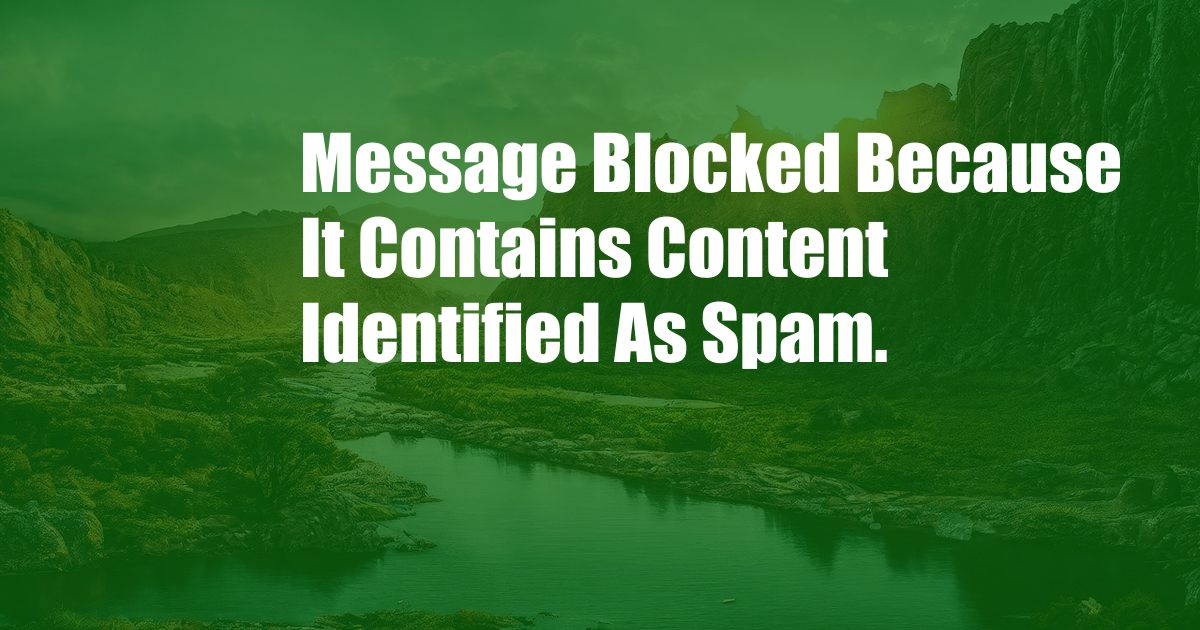
Message Blocked Because It Contains Content Identified as Spam
Have you ever encountered the frustrating situation where your email or message gets blocked because it’s flagged as spam? It can be infuriating, especially when you’re trying to send a legitimate and important message. Understanding the reasons behind this blockage and learning how to avoid it is crucial for effective communication.
Spam filters are designed to protect users from malicious and unsolicited emails. They rely on various criteria to identify messages that violate their policies, including content analysis, sender reputation, and recipient behavior. Spam filters can be complex and constantly evolving, making it challenging to keep up with their ever-changing rules.
Understanding Anti-Spam Measures
Anti-spam measures typically involve content analysis, sender reputation, and recipient behavior. Content analysis examines the words, phrases, and links within a message to identify patterns associated with spam, such as excessive capitalization, special characters, and suspicious URLs.
Sender reputation is also a key factor. Emails from known spammers or senders with a history of sending spam are likely to be blocked. On the other hand, messages from reputable senders with a positive track record are more likely to be delivered.
Recipient behavior can also influence whether a message is marked as spam. If recipients frequently mark certain senders as spam, those senders are more likely to be blocked. Conversely, if recipients consistently open and interact with emails from a particular sender, it improves the sender’s reputation and reduces the chances of their messages being flagged.
Avoiding Spam Filters
To avoid having your messages blocked as spam, it’s essential to follow best practices when crafting and sending emails:
- Use a clear and informative subject line. Avoid sensational or misleading subject lines that could trigger spam filters.
- Personalize your messages. Generic, mass-produced emails are often flagged as spam. Tailor your messages to specific recipients and include personalized content.
- Avoid excessive formatting and images. Excessive use of formatting, such as bold or italic text, and large images can raise red flags for spam filters.
- Use caution with attachments. Attaching executable files (.exe, .zip, etc.) can trigger spam filters. Limit attachments to essential files and use caution when opening attachments from unknown senders.
- Monitor your sender reputation. Track your email delivery rates and open rates. If you notice a decline, it could indicate a problem with your sender reputation.
Expert Advice for Sending Spam-Free Messages
In addition to the general tips above, here are some expert pieces of advice to help you craft spam-free messages:
- Use a reputable email service provider. Choose an email provider with a good reputation for delivering legitimate emails.
- Authenticate your emails. Implement email authentication protocols like DKIM and SPF to verify the authenticity of your emails.
- Build a strong sender reputation. Consistently send high-quality, relevant emails that recipients find valuable.
- Monitor your campaigns. Track the performance of your email campaigns and make adjustments as needed to improve deliverability.
- Be responsive to complaints. If recipients mark your emails as spam, respond promptly and take steps to address their concerns.
FAQs on Spam Filtering
Q: Why was my message blocked as spam?
A: Your message may have been flagged as spam due to content analysis, sender reputation, or recipient behavior. Check for any suspicious content, verify your sender reputation, and ensure that recipients have not marked your emails as spam in the past.
Q: How can I appeal a blocked message?
A: If you believe your message was blocked in error, you can contact the recipient’s email provider and appeal the decision. However, it’s essential to resolve any underlying issues that may have triggered the spam filter.
Q: What are some common spam triggers?
A: Common spam triggers include excessive use of exclamation points, special characters, and ALL CAPS, as well as links to suspicious websites or requests for personal information.
Conclusion
Understanding the reasons behind spam filtering is crucial for effective communication. By adhering to best practices and incorporating expert advice, you can avoid having your messages blocked and ensure that your emails reach their intended recipients. Stay informed about the latest trends in anti-spam measures, and always strive to send high-quality, relevant emails that provide value to your recipients.
Would You Like More Information on This Topic?
If you found this article informative and would like to learn more about message blocking and spam filtering, here are some additional resources: